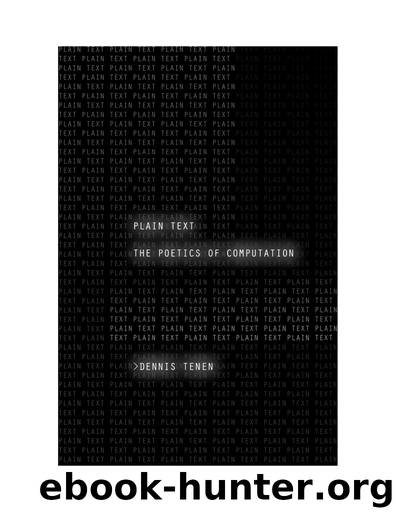Plain Text by Dennis Tenen

Author:Dennis Tenen [Tenen, Dennis]
Language: eng
Format: epub
Publisher: Stanford University Press
Published: 2017-04-14T16:00:00+00:00
PROGRAMMABLE MEDIA
To begin, we need some background on telegraphy. The turn of the twentieth century was a pivotal period in the history of letters. It saw the languages of people and machines enter the same mixed communications stream. Artificial fixed-length alphabets, such as the Baudot code, paved the way for the automation of language. The great variety of human scripts was reduced to a set of discrete and reproducible characters. So regularized, type was converted into electric signal, sent over great distances, and used to program machines remotely. These expanded textual affordances came at a price of legibility. Initially, a cadre of trained machine operators was required to translate human language into machine-transmittable code. Eventually, specialized equipment automated this process, removing humans from the equation. Machines could communicate with other machines without human intervention, triggering a chain of cascading events that reverberate today, from algorithmic financial trading to the war between junk mail (spam) generators and their filters.
The advent of programmable media (punch cards and ticker tape) coupled human-compatible alphabets with machine control code.10 Reduced to a discrete and reliably reproducible set of characters, natural languages could be conveyed as electric signals. In such a transitive state, language became more mobile than ever before. It was transmitted efficiently across vast distances. The mechanization of type also introduced new control characters into circulation that were capable of affecting machine state changes at a distance. Initially, such state changes were simple: “begin transmission,” “sound error bell,” or “start new line.” With time, they developed into what we now know as programming languages. Content meant for people was being routinely intermixed with code meant to control machine devices. Such early remote capabilities were quickly adapted to control everything from radio stations to advertising billboards and knitting machines.11
Language compressed and pushed through the wires underwent a number of transformations. Donald Murray, the inventor of the popular Murray telegraph alphabet, conceived of telecommunications in terms of time and space. Advancing a self-professed “metaphysics of telegraph signalling alphabets,” he described spatial writing symbols that “appeal to the eye” and temporal “telephonic” signals that “appeal to the ear.”12 Paradoxically, space signals (e.g., words on a billboard) occupy little space but persist in time: “For instance, a signboard may extend over 10 feet and 100 years.”13 By contrast, time signals dilate in space, whereas they contract in time: “A Morse signal in a wire may extend over half a second” and 500 miles, Murray wrote.14
Physical structures such as sentences and paragraphs that appear on a page take shape in the reader’s mind. Unlike a painting, a paragraph cannot be perceived wholly and at once; it must be reassembled mentally. The printed word extends in time. By contrast, the electric signal is nearly instantaneous. However, it claims space in transmission. A perceptive reader of electric letters reconstructs a sign’s spatial characteristics along with its temporal characteristics. The digital inscription gains a new dimension, which extends away and beyond a reader’s field of vision. Elongation in space compounds elongation in time to complicate the tactics of reading.
Download
This site does not store any files on its server. We only index and link to content provided by other sites. Please contact the content providers to delete copyright contents if any and email us, we'll remove relevant links or contents immediately.
Cecilia; Or, Memoirs of an Heiress — Volume 1 by Fanny Burney(32001)
Cecilia; Or, Memoirs of an Heiress — Volume 3 by Fanny Burney(31424)
Cecilia; Or, Memoirs of an Heiress — Volume 2 by Fanny Burney(31369)
The Great Music City by Andrea Baker(30620)
We're Going to Need More Wine by Gabrielle Union(18583)
All the Missing Girls by Megan Miranda(14518)
Pimp by Iceberg Slim(13694)
Bombshells: Glamour Girls of a Lifetime by Sullivan Steve(13655)
Fifty Shades Freed by E L James(12871)
Talking to Strangers by Malcolm Gladwell(12787)
Norse Mythology by Gaiman Neil(12738)
For the Love of Europe by Rick Steves(11260)
Crazy Rich Asians by Kevin Kwan(8844)
Mindhunter: Inside the FBI's Elite Serial Crime Unit by John E. Douglas & Mark Olshaker(8641)
The Lost Art of Listening by Michael P. Nichols(7096)
Enlightenment Now: The Case for Reason, Science, Humanism, and Progress by Steven Pinker(6841)
The Four Agreements by Don Miguel Ruiz(6270)
Bad Blood by John Carreyrou(6245)
Weapons of Math Destruction by Cathy O'Neil(5778)
